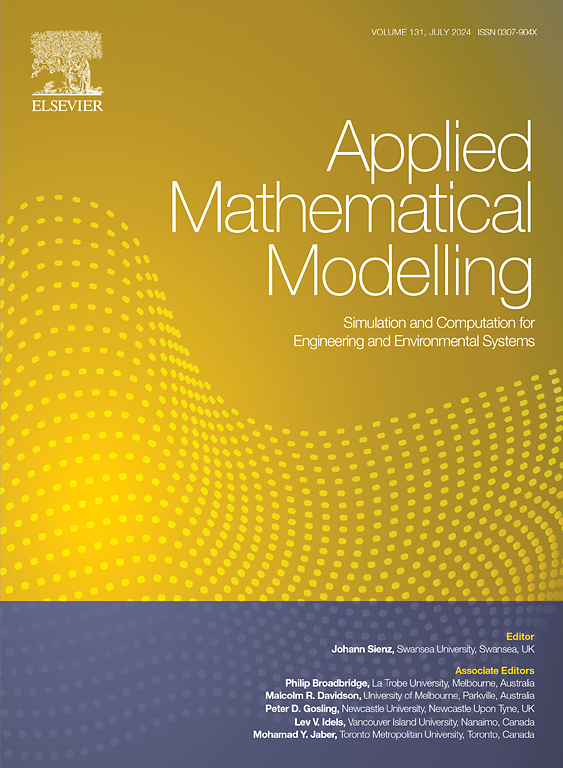复合材料准静态热力学问题的高阶多尺度神经网络方法
IF 4.4
2区 工程技术
Q1 ENGINEERING, MULTIDISCIPLINARY
引用次数: 0
摘要
基于神经网络的复合材料多物理场、多尺度问题的高精度模拟,由于计算成本高和频率原理的限制,一直是一项具有挑战性的任务。本研究结合了高阶多尺度方法和基于神经网络的方法的计算优势,提出了一种高精度、高效的复合材料准静态热力学问题计算的高阶多尺度神经网络方法。在高阶多尺度神经网络的计算框架下,高阶多尺度方法将原来复杂的多尺度问题分解为宏观均匀化问题和微观单元胞问题两部分。然后用神经网络方法对这两部分进行无网格计算。特别是,改进的物理信息神经网络被开发用于计算具有不同物理场之间显著数量级差异的宏观均质热力学问题。最后,通过具有代表性的复合材料二维和三维数值模拟实例,验证了所提高阶多尺度神经网络方法的准确性和有效性。本文章由计算机程序翻译,如有差异,请以英文原文为准。
High-order multi-scale neural network method for quasi-static thermo-mechanical problems of composite materials
The high-accuracy simulation of multi-physics and multi-scale problems of composite materials with a neural network approach remains a challenging task due to costly computation and Frequency Principle. In this study, a novel high-order multi-scale neural network approach with high-accuracy and efficiency performance is developed to compute the quasi-static thermo-mechanical problems of composite materials, which combines the computational advantages of the high-order multi-scale method and the neural network-based method. In the computational framework of high-order multi-scale neural network, the high-order multi-scale method decomposes the original complex multi-scale problem into two parts, namely, the macroscopic homogenized problem and the microscopic unit cell problems. Then the neural network method mesh-free computes these two parts. In particular, revised physics-informed neural networks are developed to calculate macroscopic homogenized thermo-mechanical problems with significant order of magnitude differences between different physical fields. Finally, the accuracy and efficiency of the proposed high-order multi-scale neural network method are demonstrated by representative numerical examples of two- and three-dimensional simulations of composite materials.
求助全文
通过发布文献求助,成功后即可免费获取论文全文。
去求助
来源期刊

Applied Mathematical Modelling
数学-工程:综合
CiteScore
9.80
自引率
8.00%
发文量
508
审稿时长
43 days
期刊介绍:
Applied Mathematical Modelling focuses on research related to the mathematical modelling of engineering and environmental processes, manufacturing, and industrial systems. A significant emerging area of research activity involves multiphysics processes, and contributions in this area are particularly encouraged.
This influential publication covers a wide spectrum of subjects including heat transfer, fluid mechanics, CFD, and transport phenomena; solid mechanics and mechanics of metals; electromagnets and MHD; reliability modelling and system optimization; finite volume, finite element, and boundary element procedures; modelling of inventory, industrial, manufacturing and logistics systems for viable decision making; civil engineering systems and structures; mineral and energy resources; relevant software engineering issues associated with CAD and CAE; and materials and metallurgical engineering.
Applied Mathematical Modelling is primarily interested in papers developing increased insights into real-world problems through novel mathematical modelling, novel applications or a combination of these. Papers employing existing numerical techniques must demonstrate sufficient novelty in the solution of practical problems. Papers on fuzzy logic in decision-making or purely financial mathematics are normally not considered. Research on fractional differential equations, bifurcation, and numerical methods needs to include practical examples. Population dynamics must solve realistic scenarios. Papers in the area of logistics and business modelling should demonstrate meaningful managerial insight. Submissions with no real-world application will not be considered.
 求助内容:
求助内容: 应助结果提醒方式:
应助结果提醒方式:


